No matter what your riding level, taking yourself out of the comfort zone to gnaw at the limits of your bike’s adhesion – dirt corner after dirt corner –
will reward you with a thousandfold more-thrills-per-kilometre than what you’ll experience on your usual Sunday tarmac blast. Your clutch and throttle control will also get a proper workout.
To experience the differences we take two LAMS-approved dual-purpose bikes off-road for a quick city-slicker adventure. Here’s how the BMW G 650 GS Sertão and Suzuki’s V-Strom 650 ABS LAMS stacked up, including a few tips for the new-to-intrepid craft of riding.
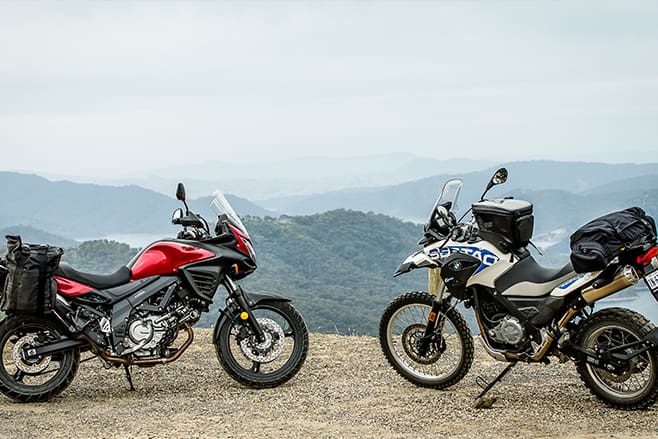
Key riding differences:
Apart from getting out of the saddle and using your feet to help balance the bike, one of the biggest differences to riding on tarmac is kicking the habit of leaning with the bike into corners. You need to remain upright – which gives more grip on the edge of the tyre. It feels strange initially as it’s the opposite to what you’d do on the road.
Riding on loose dirt and gravel offers less grip compared to bitumen. Riding on tarmac, most riders are terror-stricken about the back stepping out. We often brag about having ‘a moment’ and getting away with it – thanks to skill, luck, or traction control. But riding off-road, you soon start to revel in stringing these moments together.
Get your goggles ready – this is an epic bike for learners
The BMW G 650 GS Sertão is one of those bikes that will spur you to spend weekends seeking out adventures on dirt roads. While it makes a perfect city commuter, it really shines off-road and you’ll be building your bike-handling skills at a quicker rate compared to a machine that’s only capable of being ridden on the tarmac. No wonder even MotoGP legends such as Valentino Rossi like to get out on the dirt – it helps them keep their throttle, clutch and slide controls in top form.
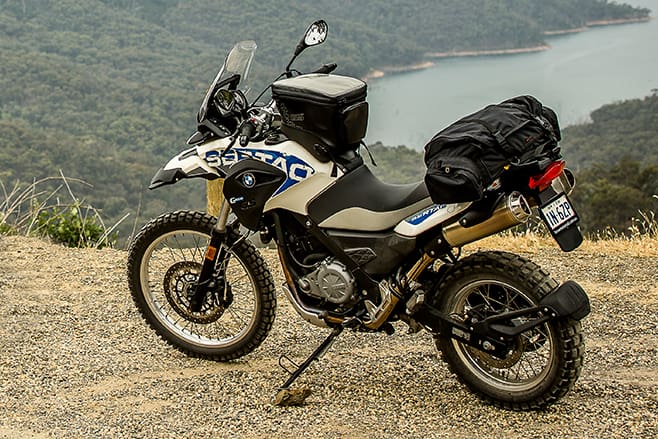
The Sertão has off-road oriented suspension, offering 210mm of travel at both ends. It soaks up bumps, deals well with ruts and gives you the confidence to tackle bigger obstacles. The 21-inch front wheel is great for keeping the front end planted on the loose stuff and the knobby Metzeler Tourance tyres bite the dirt like a shark into seal blubber.
The obvious downside to the dirt-oriented tyres and tall suspension is the way it rides on tarmac. There’s quite a bit of front-end dive under heavy braking and the tyres start to feel wishy-washy when cranked hard into a corner and there are plenty of vibrations at cruising speeds.
It’s the perfect bike for learners who don’t want to restrict themselves to sealed-road adventures
But hey, if have your heart set on setting fast lap times at your nearest racetrack, this adventure bike segment isn’t your cuppa tea anyway.
The Beemer produces its 60Nm of grunt low in the rev range (5000rpm) and its peak power of 35kW (46hp) chimes in at 6500rpm, so you’ll rarely have to hunt for gears on a dirt road. On the tarmac, you’ll struggle to get beyond 170km/h (though who cares with our 100km/h speed limits?) and at times you’ll feel frustrated by its five-speed gearbox.
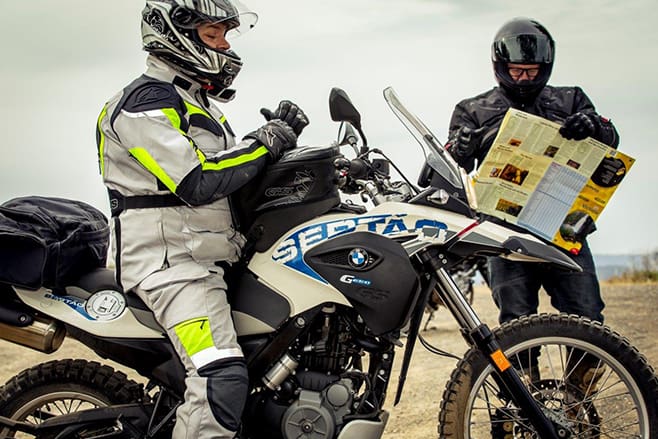
It’s certainly not a bike to rev to the red line. It also has a poorly-designed sidestand, which means the bike lurches over like the Leaning Tower of Pisa at a standstill, so even six-foot blokes like me struggle to upright it. The tank only holds 14 litres of petrol and there’s no fuel gauge – apart from a low fuel warning light.
The heated grips, ABS and screen are great. And coming in at $10,990 (+ORC), it’s one of the least expensive adventure bikes on the market. Its limitations on the tarmac are more than compensated by its immense abilities off-road. It’s the perfect bike for learners who don’t want to restrict themselves to sealed-road adventures.
Easy does it, big boy! | V-Strom loves tarmac, but shies away from hard-core dirt
Compared to the Sertão, the V-Strom weighs 21 kilos more (214 versus 193kg), which can be really felt when manoeuvring around at low speed on rutted dirt roads. But this feeling of extra bulk vanishes once you’re on the motorway, where it feels more planted. The road-biased Bridgestone Trail Wing tyres allow you to chuck the bike about on the tarmac like the young Marc Marquez many of us wanna be, but kneecaps the big Suzuki on the dirt, where it feels a bit like a fish out of water. But this could be easily sorted with the fitment of chunkier tyres which grip better on loose gravel.
Given its more road-biased design, it has a 19-inch front wheel and relatively little suspension travel (150mm on the front and 159mm on the rear), which saps the confidence when the going gets a bit tough on the dirt.
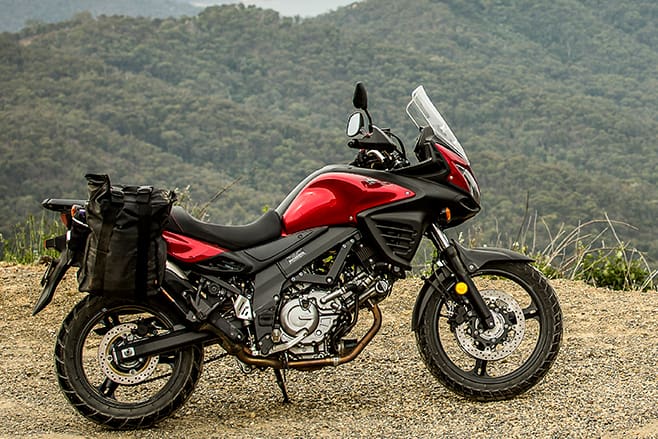
The V-Strom also has a relatively aggressive throttle – which makes it feel more responsive and much more alive on tarmac, but more fear-inducing on dirt, where you want a smooth lazy-feeling throttle which doesn’t make the bike lurch forward at every millimetre of throttle movement.
It also produces the same power (35kW) and torque (60Nm) as the Sertão, but tellingly the peak power is produced high in the rev range (8000rpm) and peak torque comes on song at 6400rpm. So it’s a pure joy to fang about on the tarmac, where getting the smooth V-twin engine near the redline rewards you with great thrills. The slick six-speed gearbox also accentuates its road-biased traits and it will hit 200km/h – good for getting to the shops in a hurry.
The ergonomics are spot-on and the seat is wide and supportive. Pillions are also well catered for, with a chunky grab handle.
On the downside, the Suzuki has some cheap-looking componentry, including universal-fit mirrors – one of which came loose from its mounting and flopped about like a flag in a storm. Looks-wise, it’s not exactly Scarlett Johansson, though I’m sure it’ll grow on you.
Priced at $9990 ride-away it’s a lot of bike for your bucks. Given the fact it rides so well on the tarmac and that you could easily punt it along many dirt roads, despite its off-road limitations, it’s a hard bike to look past for learners.
Hints for new adventurers
1. Adventure bikes aren’t trailbikes
They are obviously bigger, heavier and posses less suspension travel. Modify the way you ride and where you go accordingly. Choose a bike to suit where you want to go. Big distance road touring with a bit of dirt thrown in requires a very different bike to hard core desert crossings. Tyres are a fraught compromise. Road based tyres last but don’t bite much on the dirt and dirt tyres grip but wear out quick.
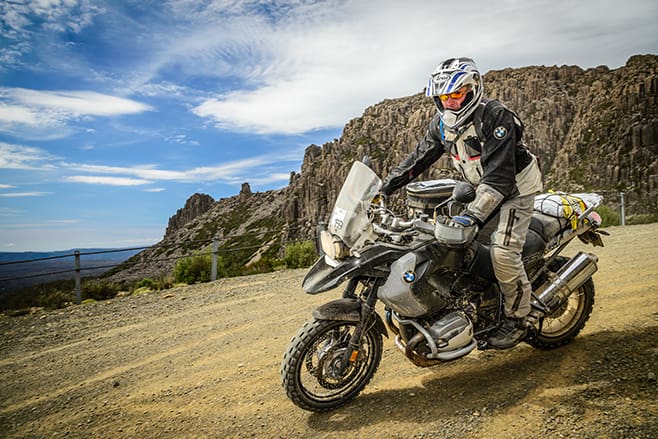
2. Look ahead
The “you go where you look” adage is no more important than on a dirt road. Get over target fixation on ruts and little piles of gravel ahead. Look at where you want to be not at where you are and plan how to get there. You’ll hear advice along the lines of “look ahead”, that’s half the story. Making a decision about the best part of the road to ride on, the best gap in rocks, the best rut to attack. Follow the guides below and the bike will do the rest.

3. Keep a tight chain
When the engine has lost control of the bike, you’re next. Use the engine braking to hold the bike on the downhill and drive it up. When the master freckle is puckering and the eyes are glued to the visor opening the throttle is counter to every survival instinct. See point two and drive out. The throttle and momentum are your best friends, those who hesitate are lost! Don’t fly hell for leather at an embankment or hill but use just enough momentum and drive to reach the top in a controlled manner. Drive at the bottom more than at the top, plan to gently pop over the top, who knows what’s there!
There is no substitute for practice. Putting the bike in the shed, manoeuvring it around a servo or daily parking are all good opportunities to start to get the feel for these skills.

4. Learn clutch control
A traction control, get out of jail free card and low speed controller all in one skill. If the back end is breaking free and the waft of impending Dettol fills the air. Slipping the clutch with save the day most of the time. Get the feel of the point where the drive comes on. A great exercise is to move the bike around while standing next to it using a small amount of throttle and feathering the clutch to walk the bike about. Why push the bugger around when this works so well!
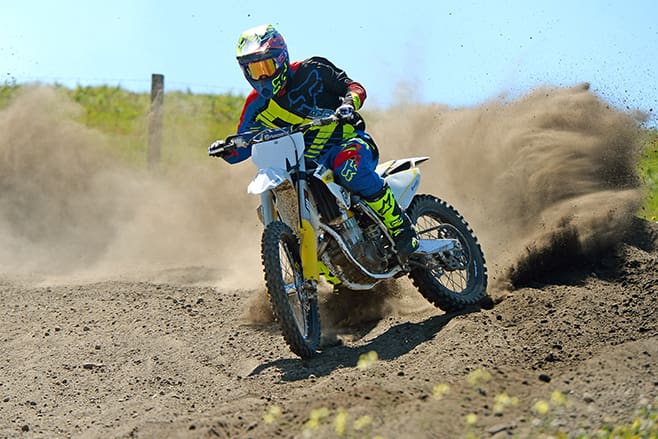
5. Stand up for better control
Find a comfortable and neutral standing position. The handle bars are just a convenient place to keep the controls. They are not for you to hang onto for grim life. By loading all your weight on the footpegs the centre of gravity has dropped as low as possible. Use your legs and feet to steer. Get the feel of the bike responding to this footpeg pressure by changing lanes or wheel tracks gently and build up control. Push the bike down with your feet but you stay relatively upright.
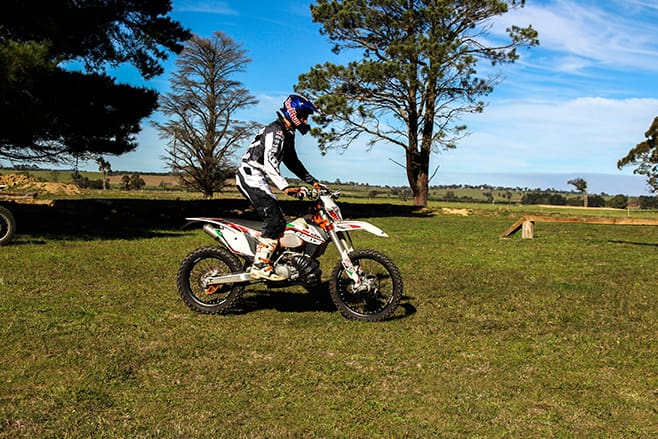
The full Into the wild article appears in AMCN Vol 64 No 12